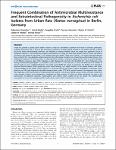Frequent Combination of Antimicrobial Multiresistance and Extraintestinal Pathogenicity in Escherichia coli Isolates from Urban Rats (Rattus norvegicus) in Berlin, Germany
Guenther, Sebastian
Bethe, Astrid
Fruth, Angelika
Semmler, Torsten
Ulrich, Rainer G.
Wieler, Lothar H.
Ewers, Christa
Urban rats present a global public health concern as they are considered a reservoir and vector of zoonotic pathogens, including Escherichia coli. In view of the increasing emergence of antimicrobial resistant E. coli strains and the on-going discussion about environmental reservoirs, we intended to analyse whether urban rats might be a potential source of putatively zoonotic E. coli combining resistance and virulence. For that, we took fecal samples from 87 brown rats (Rattus norvegicus) and tested at least three E. coli colonies from each animal. Thirty two of these E. coli strains were pre-selected from a total of 211 non-duplicate isolates based on their phenotypic resistance to at least three antimicrobial classes, thus fulfilling the definition of multiresistance. As determined by multilocus sequence typing (MLST), these 32 strains belonged to 24 different sequence types (STs), indicating a high phylogenetic diversity. We identified STs, which frequently occur among extraintestinal pathogenic E. coli (ExPEC), such as STs 95, 131, 70, 428, and 127. Also, the detection of a number of typical virulence genes confirmed that the rats tested carried ExPEC-like strains. In particular, the finding of an Extended-spectrum beta-lactamase (ESBL)-producing strain which belongs to a highly virulent, so far mainly human- and avian-restricted ExPEC lineage (ST95), which expresses a serogroup linked with invasive strains (O18:NM:K1), and finally, which produces an ESBL-type frequently identified among human strains (CTX-M-9), pointed towards the important role, urban rats might play in the transmission of multiresistant and virulent E. coli strains. Indeed, using a chicken infection model, this strain showed a high in vivo pathogenicity. Imagining the high numbers of urban rats living worldwide, the way to the transmission of putatively zoonotic, multiresistant, and virulent strains might not be far ahead. The unforeseeable consequences of such an emerging public health threat need careful consideration in the future.
Dateien zu dieser Publikation
Keine Lizenzangabe
Verwandte Publikationen
Anzeige der Publikationen mit ähnlichem Titel, Autor, Urheber und Thema.
-
2005-06-20ZeitschriftenartikelViral promoters can initiate expression of toxin genes introduced into Escherichia coli Lewin, Astrid; Mayer, Martin; Chusainow, Janet; Jacob, Daniela; Appel, BerndBackground: The expression of recombinant proteins in eukaryotic cells requires the fusion of the coding region to a promoter functional in the eukaryotic cell line. Viral promoters are very often used for this purpose. ...
-
2014-12-04ZeitschriftenartikelLow Rates of Antimicrobial-Resistant Enterobacteriaceae in Wildlife in Taï National Park, Côte d’Ivoire, Surrounded by Villages with High Prevalence of Multiresistant ESBL-Producing Escherichia coli in People and Domestic Animals Albrechtova, Katerina; Papousek, Ivo; Nys, Helene de; Pauly, Maude; Anoh, Etile; Mossoun, Arsene; Dolejska, Monika; Masarikova, Martina; Metzger, Sonya; Couacy-Hymann, Emmanuel; Akoua-Koffi, Chantal; Wittig, Roman M.; Klimes, Jiri; Cizek, Alois; Leendertz, Fabian; Literak, IvanAntimicrobial resistance genes can be found in all ecosystems, including those where antibiotic selective pressure has never been exerted. We investigated resistance genes in a collection of faecal samples of wildlife ...
-
2010-09-29ZeitschriftenartikelPpiD is a player in the network of periplasmic chaperones in Escherichia coli Matern, Yvonne; Barion, Birgitta; Behrens-Kneip, SusanneBackground: The inner membrane-anchored periplasmic folding factor PpiD is described as a parvulin-like peptidyl prolyl isomerase (PPIase) that assists in the maturation of the major beta-barrel outer membrane proteins ...

